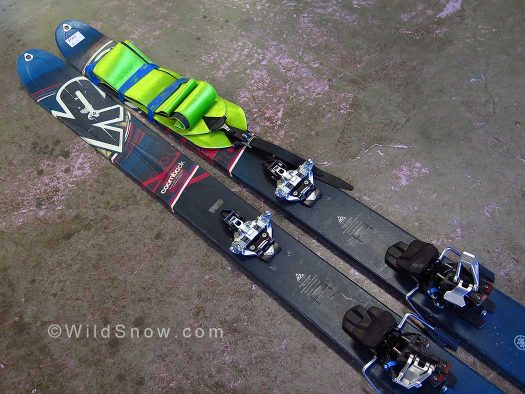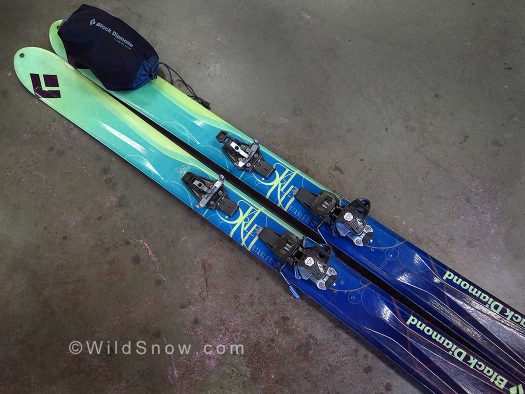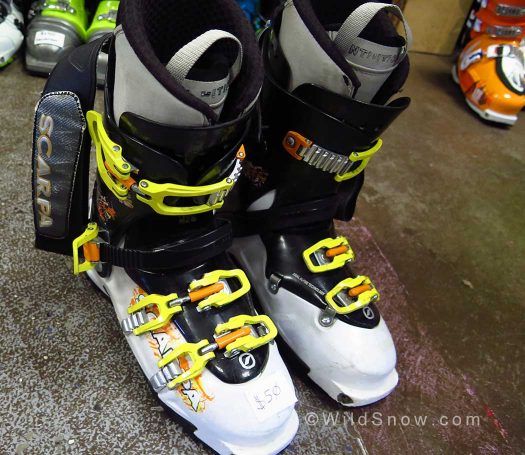For much much more money saving ski touring gear info, check our budget category.
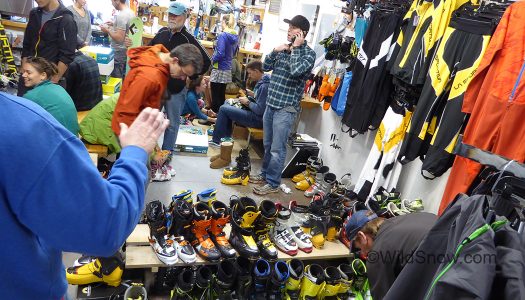
UPDATE — Today, October 29, Let it Swap!
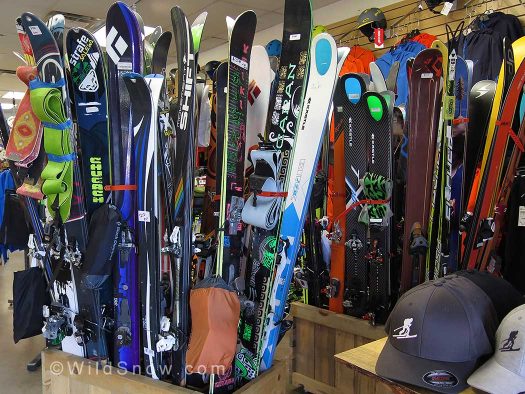
New to you, backcountry ski swap. This is how the stack looks at Cripple Creek Backcountry, just a few blocks from Wildsnow World Headquarters. Perhaps you have a local swap of your own? Or, consider contacting CCB and inquiring as to any used gear they’re stocking.
Once each year, our local backcountry ski shop here in Colorado makes the budget gear search a lot easier. This weekend (Saturday, tomorrow, 9:00 am) Cripple Creek Backcountry holds their annual “backcountry gear only” ski swap.
We did a preview of the massive gear cache, and found a number of deals that will allow Joe or Betty to outfit themselves for alpine touring, within their budget of $1000. (Idea is these are examples of what might be available on the used market, anywhere you live — and of course this is a preview if you’re local to our area.)
Boots are perhaps the trickiest backcountry skiing item to acquire on a budget. To find a boot that gives you maximum comfort and control, we recommend working with an experienced boot fitter on a total shoe-liner-footbed package, but that scenario usually means paying full retail. Working with an experienced shop employee to pair used tech-compatible boots with a new, heat-moldable liner is the budget way to get a custom fit. Just make sure you begin with a low priced boot since new liners are not exactly a budget item. That said, liners can indeed be molded multiple times. If the liner in your used boots is intact (inspect for damage that renders them useless) and heat-moldable, try re-baking, that might be all you need.
As for other touring gear:
If you buy skis with bindings, be sure to test your boot-binding combined performance before skiing your gear. Do so by clamping a boot in a binding toe and doing the tests in this blog post. If possible, buy used skins at the swap as well — purchasing skins later, at full retail, can blow your budget. Ski poles can be just about anything, ditto for backpack (it just needs to hold your safety gear and lunch, along with a layer or two).
Finding a budget avalanche beacon can seem tricky but it’s not. Despite marketing hype, just about any beacon made within the last five years is adequate if you practice with it. Important: When you inspect a used beacon, open up the battery compartment and look for excessive corrosion. A tiny bit of mung on the battery contacts can easily be cleaned, but lots of detritus indicates the beacon owner cared not — and you might not care to hand over your cash. Oh, and one other beacon test (the obvious), check the send and receive range and function by pairing with a test beacon that’s known to function within spec.
Women’s used boots: GearTrade.com, $200
Probe: BCA Stealth 240, $35.
Shovel: Voile XLM, $40.
Beacon: BCA Tracker, $240.
Avalanche course: if you don’t have the time or the money for a level one avi class, some local organizations offer public training. Mountain Rescue in our area hosts an avalanche seminar every year in Aspen and we often attend it as a refresher, $30. If you can’t swing an avy safety course, be sure to read up on the subject, ski with individuals more experienced than you, and practice beacon searches with a friend. Hide a beacon in the house or yard and go find it. Doing so is easy and quick, and a little practice makes a world of difference when you’re in the field.
Budget tally:
Joe
Used skis, bindings, skins from swap, $500
Used boots, $50
New Intuition liners to mold, $200
Probe, $35
Shovel, $40
Beacon, $240
Avi seminar, $30
Total, $1,095
Betty
Used skis, bindings, skins from swap, $450
Used boots (remold old liners), $200
Probe, $35
Shovel, $40
Beacon, $240
Avi seminar, $30
Total, $995
For much much more money saving ski touring gear info, check our budget category.
Lastly, the bloated elephant in the room: Should you buy a used avalanche airbag system? If visual inspection and owner testimony indicates a balloon pack is in good shape and functional, we don’t see why not. Only challenge is you should trigger and inflate any used balloon pack you consider buying, and doing so will often result in expensive or at least time consuming canister swaps-refills. Hence, unless a used avy airbag pack is priced fairly, you can end up spending so much time and money on it you might as well get a new one. (And yes, there are indeed two battery powered airbag brands now — they’ll eventually end up on the used market. We’re not sure how to evaluate these, our instincts tell us to put the battery in your freezer at home, wait 6 hours or so, re-install in the pack, then see if you can get three or more inflations out of it. If so, we’d say the battery is good to go.)
While most of the WildSnow backcountry skiing blog posts are best attributed to a single author, some work well as done by the group.

